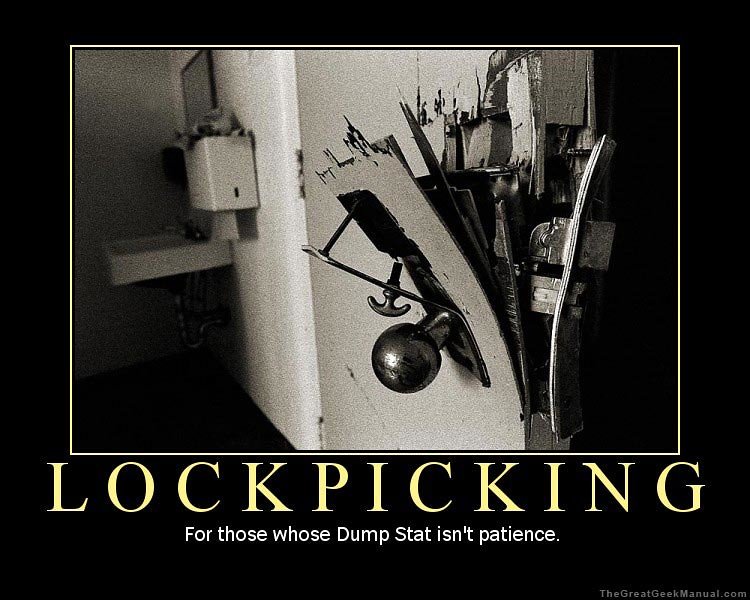Locked doors, impenetrable vaults, and secured safes may seem insurmountable, an impenetrable fortress guarding its secrets from prying eyes and determined fingers. A mystifying blend of art and science, lock picking stands as a testament to human ingenuity and the unwavering pursuit of knowledge. And at the heart of this ancient craft lies a crucial element that tiptoes delicately between success and failure—the role of tension. In this beginner’s guide, we unravel the enigma that is tension, exploring its significance, techniques, and the delicate dance it performs with the pins, revealing the secrets to unlocking the mysteries that lie safely behind closed doors.
Table of Contents
- The Many Faces of Tension: Understanding Its Crucial Role in Lock Picking
- Unmasking the Art of Applying Tension: Techniques and Tools for Beginners
- Navigating the Fine Line: Balancing Tension in Lock Picking
- Mastering the Art of Feedback: Utilizing Tension to Read Locks like a Pro
- So You’ve Got the Hang of It: Fine-tuning Your Tension to Improve Lock Picking Skills
- Q&A
- In Retrospect

The Many Faces of Tension: Understanding Its Crucial Role in Lock Picking
Tension, the elusive yet essential key to unlocking a realm filled with intrigue and mystery. At the heart of every successful lock picking endeavor lies a delicate balance of applied force and subtlety, a dance between a tension wrench and pins. Understanding the many facets of tension is the key to becoming a master of this ancient art.
First and foremost, tension determines the outcome. Apply too much force, and the delicate pins may snap under the strain, crippling any hopes of breaching the lock’s barrier. Conversely, too little tension renders the delicate balancing act obsolete, as the pins remain unwilling to shift their positions. It is this nuanced control of tension that sets apart the novice from the adept lock picker.
- Incremental Progress: One of the primary roles tension plays is guiding the lock picker’s progress. As one applies the slightest of forces to the tension wrench, each incorporated pin will subtly communicate its state of being – be it resistance, alignment, or a teasing indication of readiness to be set. Through this delicate interplay with tension, the lock picker can discern the path to success.
- The Tactile Connection: Lock picking is as much a physical experience as it is a mental one. The synergy between the lock picker’s fingertips and the tension wrench is a dance of feeling and intuition. The grip, finger position, and the pressure applied to the tension wrench—all these factors contribute to the transmission of the picker’s will to the core of the lock. It is this tactile connection that transforms an inanimate tool into an extension of the picker’s hand.
- The Zen of Tension: Beyond its mechanical implications, the role of tension delves into the realm of philosophy and psychology. Like a master archer, the skilled lock picker embodies focus, discipline, and patience. Tension requires the picker to enter a zone of heightened awareness, where the mind silences distractions, and the world around recedes. In this moment of tranquility, the picker becomes one with the lock, sensing its hidden secrets and embracing the ultimate challenge.
So, as you embark on your journey to unlock the mysteries entwined within locks, remember that tension holds the key to success. Nurture your understanding of this multifaceted force, and uncover the hidden depths of lock picking mastery.

Unmasking the Art of Applying Tension: Techniques and Tools for Beginners
When it comes to creating art, applying tension is an essential skill that can bring depth and interest to your work. Whether you are a beginner or an experienced artist looking to enhance your technique, understanding the art of tension is a crucial step in your creative journey.
So, how can you apply tension effectively in your artwork? Here are some techniques and tools that can help you master this captivating art form:
- Contrast: Utilize the power of contrast to create tension between elements in your composition. Experiment with contrasting colors, shapes, sizes, or textures to emphasize the differences and create visual interest.
- Composition: Mindful arrangement of elements within your artwork can greatly impact the tension it generates. Play with the rule of thirds, leading lines, or negative space to guide the viewer’s eye and create dynamic tension within the composition.
- Line and Form: The use of bold, expressive lines and bold shapes can add tension and energy to your artwork. Experiment with different line weights and varying forms to create a sense of movement and intrigue.
- Texture: Incorporate different textures into your artwork to create tactile tension. This can be achieved through various mediums such as adding collaged elements, using different brushstroke techniques, or experimenting with mixed media.
- Light and Shadow: Understanding how light interacts with your subject matter is a powerful tool for creating tension. Experiment with chiaroscuro techniques, dramatic lighting, or strong contrasts between light and shadow to add depth and intrigue to your artwork.
By honing your skills in applying tension through these techniques and utilizing the right tools, you can elevate your artwork to a new level of artistic expression. Embrace the art of tension and watch your creations come alive with captivating depth and intrigue!

Navigating the Fine Line: Balancing Tension in Lock Picking
When it comes to the delicate art of lock picking, there is a fine line that must be navigated – balancing tension. This essential skill is the key that unlocks the secrets held within a lock, allowing the pick to manipulate its inner workings and grant access to its hidden treasures.
But finding that delicate balance can be a challenge. Too much tension, and the fragile pins within the lock will bind, refusing to budge. Too little tension, and the pick will simply glide over them, unable to engage. It is a game of precision and finesse, where every movement must be calculated and controlled.
To achieve this delicate equilibrium, a lock picker must learn to read the subtle cues given by the lock. The feedback transmitted through the pick’s handle becomes an intricate dance of touch and response. Through years of practice and experience, the picker becomes attuned to the slightest fluctuations in tension, adjusting their touch accordingly.
- Mastering the Touch: Balancing tension requires an intimate understanding of the lock’s inner workings. Each lock possesses a unique personality and requires a slightly different touch. As a picker gains experience, they develop a feel for the specific feedback each lock provides, enabling them to adjust their tensioning technique accordingly.
- Listening to the Pins: A skilled picker knows that tension is not a one-size-fits-all affair. Like a conductor leading an orchestra, they must “listen” to each pin as it dances under their touch. The pins reveal their secrets through subtle vibrations and clicks, guiding the picker on the path to success. The balance of tension is a delicate interplay between the picker’s touch and the lock’s response.
- The Art of Patience: Balancing tension is a test of patience and perseverance. It requires the picker to maintain a steady hand and a calm mind, resisting the temptation to rush or apply unnecessary force. Like a skilled tightrope walker, they must walk the fine line between too much and too little, finding the perfect equilibrium to unlock the puzzle before them.
Mastering the Art of Feedback: Utilizing Tension to Read Locks like a Pro
Unlocking the secrets of a locked door can be a thrilling challenge for those with a curious mind. Whether you are a locksmith or simply someone with an insatiable interest in the mechanics of locks, mastering the art of feedback is crucial to your success. One technique that professionals swear by is utilizing tension to read locks like a pro.
When applying tension to a lock, it’s important to remember that subtlety is key. A heavy hand can easily result in a broken lock or an unsuccessful attempt. Start by gently applying tension with your tension wrench, feeling for any slight movement or resistance. Take your time and listen to the subtle feedback that the lock provides. Is there a click or a slight give? This is your cue to adjust your technique and follow the path towards unlocking success.
- Develop a sensitive touch: Like an artist mastering their craft, becoming proficient at reading locks requires a delicate touch and a heightened sense of touch. Pay attention to the feedback your fingertips receive and use it as a guide.
- Listen to the lock: Locks have a language of their own, and it’s up to you to decipher it. Take the time to familiarize yourself with the various clicks and signals that different locks provide. Each lock will have its own unique voice, and it’s through careful listening that you’ll unlock its secrets.
- Embrace the challenge: Reading locks takes patience and perseverance. As you encounter different locks, each with its own idiosyncrasies, view each one as a puzzle waiting to be solved. Embrace the challenge and let the tension drive your determination to succeed.
So, the next time you find yourself face to face with a locked door, remember to utilize tension as your guide. By mastering the art of feedback and unleashing the power of your senses, you’ll be able to read locks like a true professional. Happy unlocking!
So You’ve Got the Hang of It: Fine-tuning Your Tension to Improve Lock Picking Skills
Once you have familiarized yourself with the basics of lock picking, it’s time to take your skills to the next level. A crucial aspect of successful lock picking is fine-tuning your tension technique. By mastering the art of tension, you will greatly improve your chances of opening even the most stubborn locks. Here are some key tips to help you fine-tune your tension:
- Light but Firm: When applying tension to the lock, it is essential to strike the right balance between lightness and firmness. Applying too much pressure can lead to the pins binding, making it nearly impossible to unlock. On the other hand, too little tension will result in ineffective picking. Practice finding the sweet spot where you exert just enough force to keep the pins engaged, but not so much that they become overly resistant.
- Feedback is Key: Pay close attention to the feedback you receive from the lock as you apply tension. Often, locks provide subtle cues that can guide you towards success. Listen for slight clicks, feel for tiny vibrations, and observe any slight rotation or movement in the lock cylinder. These signals indicate that you are on the right track and can help you adjust your tensioning technique accordingly.
- Experiment with Tension Tools: Tension tools come in a variety of shapes and sizes, each offering a unique advantage. Some are designed to provide more control, while others allow for better feedback. Don’t be afraid to experiment with different tools to discover what works best for you. Remember, finding the perfect tension tool is just as important as finding the ideal tension itself.
As with any skill, improving your tension technique requires time, patience, and practice. The more you dedicate yourself to honing this aspect of lock picking, the more proficient and successful you will become. So keep on fine-tuning your tension, and watch as your lock picking skills soar to new heights!
Q&A
What is the role of tension in lock picking?
Tension is a crucial element in lock picking as it creates the necessary pressure needed to manipulate the lock’s pins. Applying the right amount of tension is essential to facilitate the movement of the pins and successfully open the lock.
Why is it important for beginners to understand tension in lock picking?
Understanding tension is fundamental for beginners as it allows them to grasp the mechanics of lock picking. It forms the foundation of the entire process, and without a solid understanding of tension, success in lock picking can be elusive.
How can beginners effectively apply tension when picking a lock?
Beginners should start by applying a light and steady rotational force using a tension wrench in the desired direction of lock rotation. It is crucial to maintain consistent tension throughout the process, as too much or too little can hinder successful picking.
Can too much tension be detrimental to lock picking?
Yes, excessive tension can make it difficult to maneuver the lock’s pins, often resulting in a lock jam. It is important to find the delicate balance between enough tension to manipulate the pins and avoid excessive force that can lead to lock damage.
What are some tips for beginners to develop their tension skills?
Practicing with different types of locks can help beginners develop a better feel for the necessary tension. It is also beneficial to experiment with different levels of tension while picking to understand the subtle nuances required for each lock.
Is there a universal method for applying tension in lock picking?
While there are general guidelines for applying tension, the specific technique may vary depending on the lock and the individual. It is essential for beginners to practice and experiment to find the most effective and comfortable method for themselves.
How does tension play a role in increasing lock picking speed?
With experience, lock pickers can develop a greater sensitivity to tension, allowing them to quickly determine the correct amount needed for a particular lock. This increased efficiency in applying tension enables them to pick locks more swiftly and smoothly.
In Retrospect
As we conclude this gripping journey into the enigmatic world of lock picking, it becomes abundantly clear that tension holds the key to unraveling the mysteries that lie beyond closed doors. Like a master conductor orchestrating a symphony, the delicate interplay between tension and technique waltz hand in hand towards success.
From the very first touch of the tension wrench to the glorious click of the tumblers falling into place, we have embarked on an adventure that challenges our perception of security. It is through the art of tension that we empower ourselves with a newfound understanding of locks, transforming them from formidable barriers to mere puzzles waiting to be solved.
This guide has journeyed through the shadows and illuminated the path for beginners to grasp the importance of tension, for it is through this dance with pressure that the delicate mechanical mechanisms of locks yield to our will. Tugging gently, coaxing patiently, we have unearthed the secrets that lie beneath the surface, exposing the intricate inner workings of these fascinating contraptions.
It is essential to emphasize that lock picking should only be used ethically and responsibly. This newfound knowledge should not be applied for malicious purposes but rather imparted as a testament to the remarkable ingenuity of human engineering. By delving into the world of tension, we cultivate a deeper appreciation for the craftsmanship behind these objects that guard our treasures and secrets alike.
So, as the curtain falls on this introductory exploration, remember that tension is not solely confined within locks but is also mirrored within ourselves. With perseverance and dedication, this curious art form can unlock doors to personal growth and transformation. As beginners, we have merely scratched the surface of this intricate craft, but with each attempt, we inch closer to becoming true masters in this realm of tension and unlocking the secrets that lie within.
As an affiliate, my content may feature links to products I personally use and recommend. By taking action, like subscribing or making a purchase, you’ll be supporting my work and fueling my taco cravings at the same time. Win-win, right?
Want to read more? Check out our Affiliate Disclosure page.
